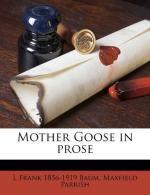“But I do n’t want you to help,” said Mary, “for this is to be my own little flower-garden, and I want to do all the work myself.”
Now I must tell you that this little girl, although very sweet in many ways, had one serious fault. She was inclined to be a bit contrary, and put her own opinions and ideas before those of her elders. Perhaps Mary meant no wrong in this; she often thought knew better how to do a thing than others did; and in such a case she was not only contrary, but anxious to have her own way.
And so her mother, who did not like her little daughter to be unhappy, often gave way to her in small things, and now she permitted Mary to make her own garden, and plant it as she would.
So Mary made a long, narrow bed at the front of the house, and then she prepared to plant her flowers.
“If you scatter the seeds,” said her mother, “the flower-bed will look very pretty.”
Now this was what Mary was about to do; but since her mother advised it, she tried to think of another way, for, as I said, she was contrary at times. And in the end she planted the dingle-bells all in one straight row, and the cockle-shells in another straight row the length of the bed, and she finished by planting the cowslips in another long row at the back.
Her mother smiled, but said nothing; and now, as the days passed by, Mary watered and tended her garden with great care; and when the flowers began to sprout she plucked all the weeds that grew among them, and so in the mild spring weather the plants grew finely.
“When they have grown up big and strong,” said Mary one morning, as she weeded the bed, “and when they have budded and blossomed and faded away again, then papa and my brothers will come home. And I shall call the cockle-shells papa, for they are the biggest and strongest; and the dingle-bells shall be brother Hobart, and the cowslips brother Robart. And now I feel as if the flowers were really my dear ones, and I must be very careful that they come to no harm!”
She was filled with joy when one morning she ran out to her flower-garden after breakfast and found the dingle-bells and cowslips were actually blossoming, while even the cockle-shells were showing their white buds. They looked rather comical, all standing in stiff, straight rows, one after the other; but Mary did not mind that.
While she was working she heard the tramp of a horse’s hoofs, and looking up saw the big bluff Squire riding toward her. The big Squire was very fond of children, and whenever he rode near the little white cottage he stopped to have a word with Mary. He was old and bald-headed, and he had side-whiskers that were very red in color and very short and stubby; but there was ever a merry twinkle in his blue eyes, and Mary well knew him for her friend.
Now, when she looked up and saw him coming toward her flower-garden, she nodded and smiled to him, and the big bluff Squire rode up to her side, and looked down with a smile at her flowers.




